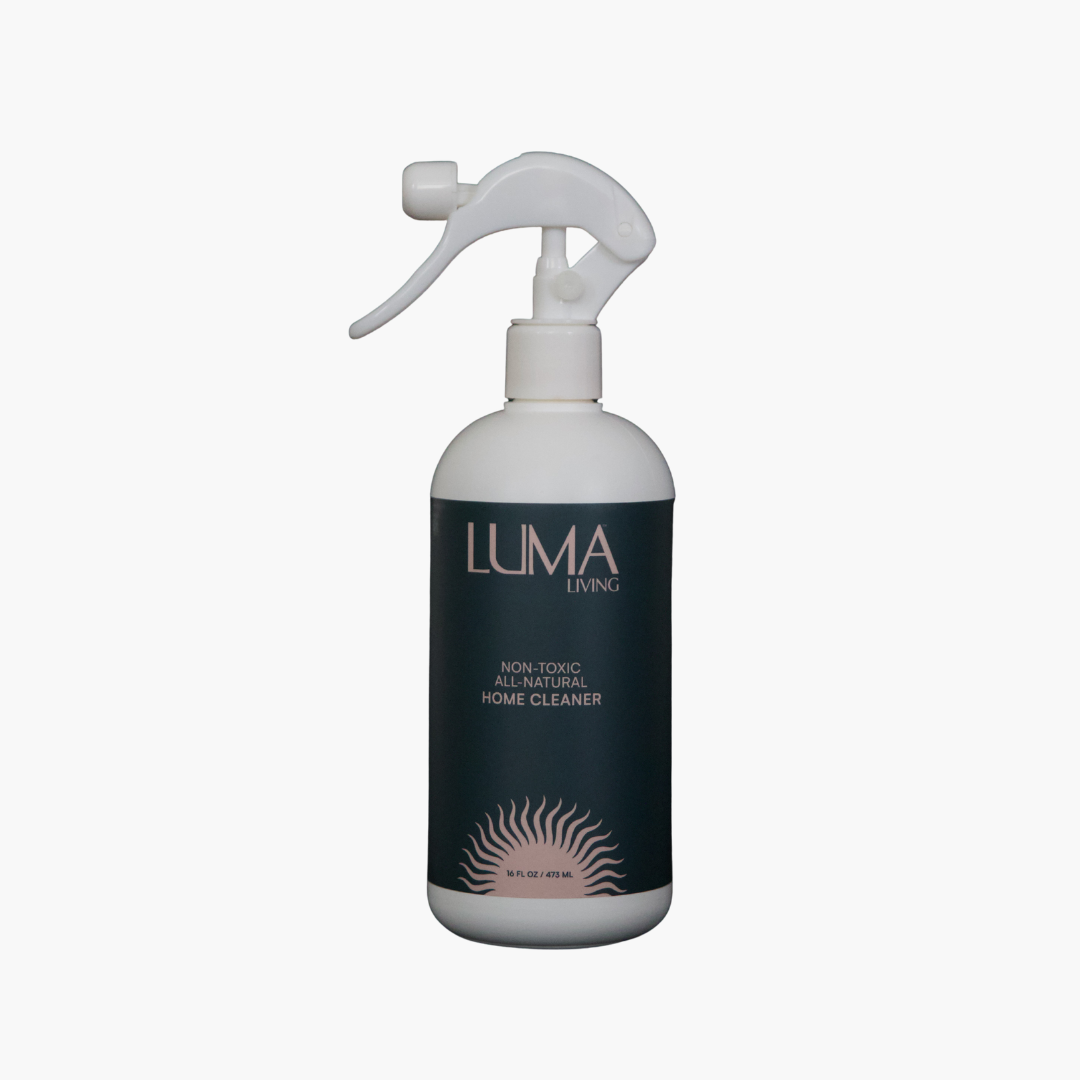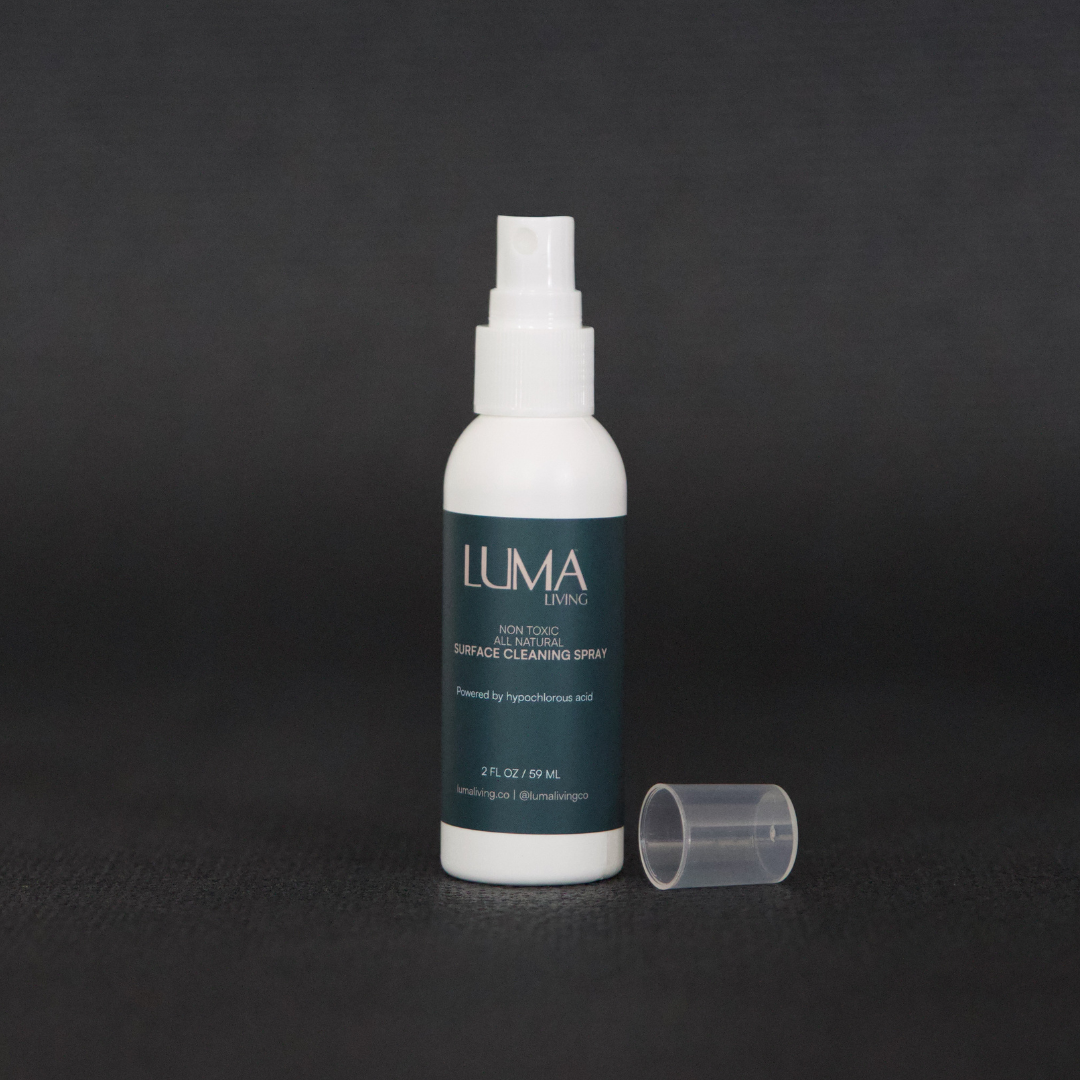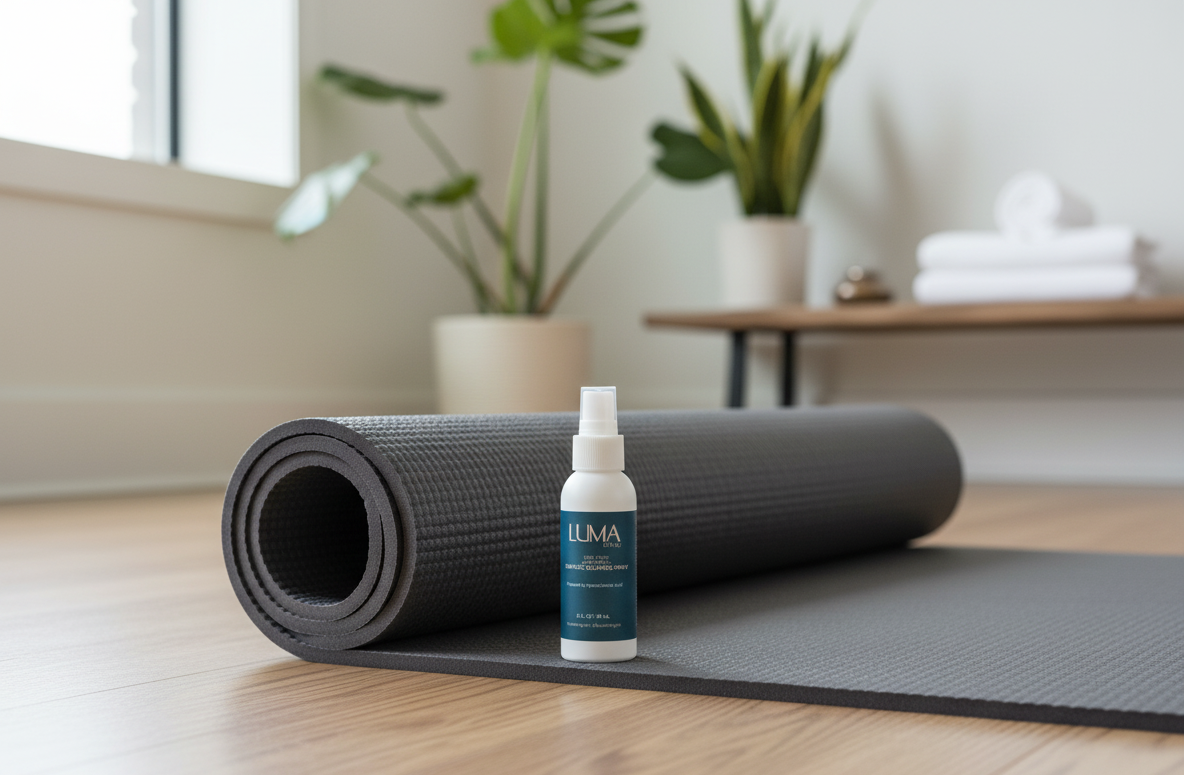A clean yoga mat supports a clear mind. The challenge is keeping it fresh without harsh chemicals or homemade mixes that leave a residue.
A truly effective non toxic yoga mat cleaner does not need complex ingredients. It should clean well and leave nothing behind. Here’s how to clean safely and simply.
A Simple Approach to a Truly Clean Yoga Mat

Your yoga mat is a personal space for your practice. Over time, sweat, dust, and oils from the skin naturally build up on its surface. Keeping this space clean is part of the practice itself.
The goal is to find a cleaner that maintains your mat, rather than detracts from it. It needs to be gentle on the material yet effective enough to leave it feeling fresh. This balance can be difficult to achieve with conventional products.
The Search for a Safe Solution
Many people try making their own cleaners with vinegar or essential oils. While well-intentioned, these recipes can sometimes create other issues. Vinegar can be too acidic for some mat materials. Essential oils often leave a slippery film that can affect your grip.
The challenge is finding a cleaner that meets a few simple criteria:
- Residue-Free: It should evaporate completely, leaving no film, stickiness, or scent.
- Family-Friendly: It should be a suitable choice for homes with children and pets.
- Simple to Use: The cleaning routine should be straightforward and calming.
A clean mat feels like nothing at all—no stickiness, no smell, just a pure surface. This simplicity supports peace of mind.
Fortunately, a science-backed solution meets these needs. It offers a way to clean your mat without compromises.
Why a Gentle Clean Matters for Your Practice
How you clean your yoga mat impacts your practice and the mat itself. Harsh chemical cleaners can break down a mat's material over time. This can cause it to become brittle, discolored, or slippery.
Many common sprays also leave behind an invisible film. This residue might irritate skin during a long hold or compromise your grip when it matters most. A gentle but effective non toxic yoga mat cleaner helps preserve the integrity of your equipment.
Beyond that, your mat is a space for peace and wellness. Strong chemical smells or concerns about skin contact can be distracting. The care of your mat should feel as intentional as your practice.
Creating a Safe Space for Wellness
A clean mat helps create a clear mind. When you step onto the surface, you should feel confident and secure. This is especially true in homes with children or pets who may also use the floor space.
The goal is a clean you do not have to think about. It is the peace of mind that comes from knowing your choice supports your well-being.
This simple act of cleaning connects to a larger commitment to a calm, healthy home. It is not about adding another chore. It is about ensuring every part of your yoga routine contributes to your overall health.
By choosing a simple, residue-free cleaner, you maintain your mat as a sanctuary. Free from distractions, you can focus completely on your breath and movement.
The Trouble with Common Yoga Mat Cleaners
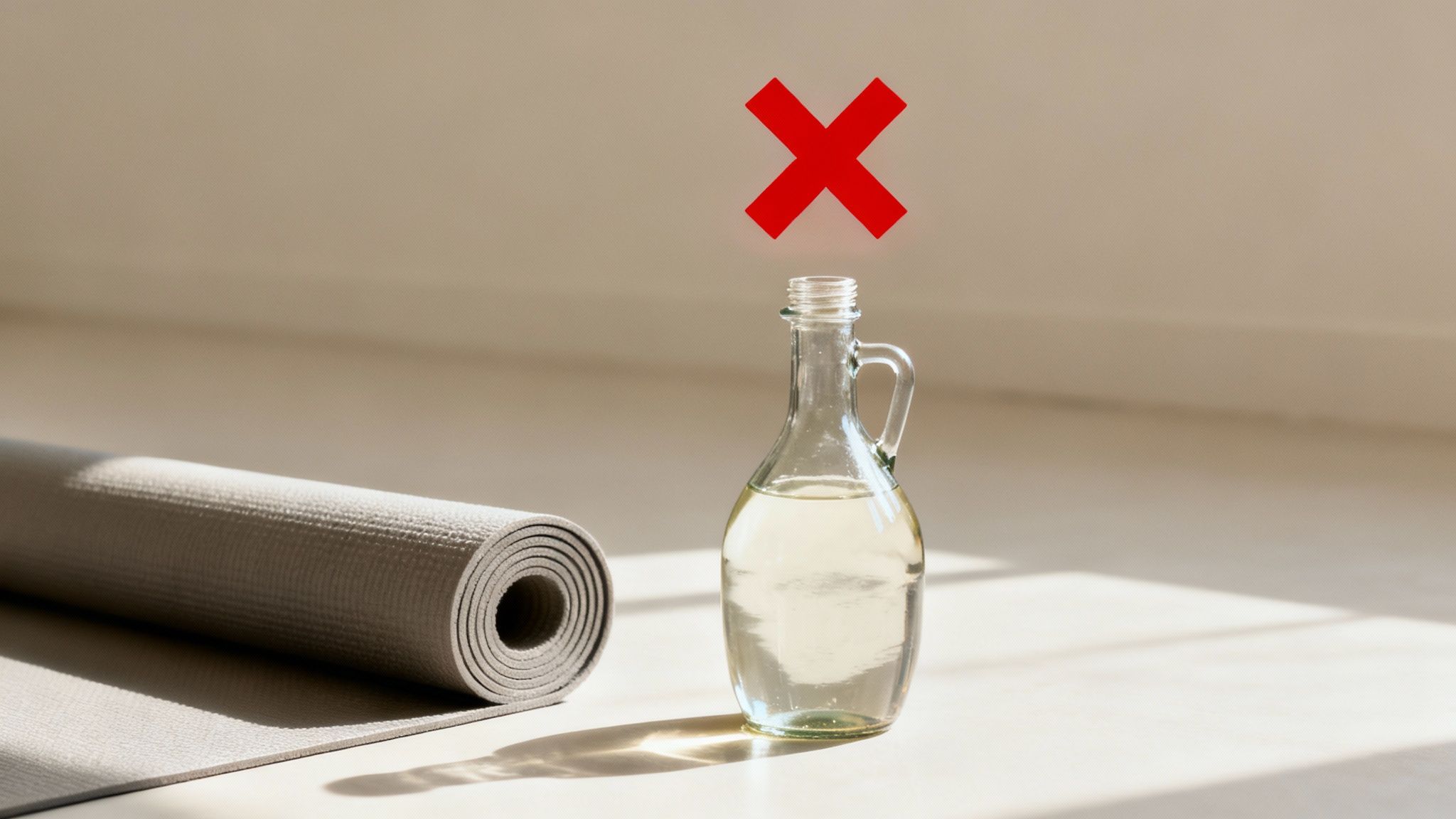
There is a lot of advice available for cleaning yoga mats. Many popular methods, however, can create more problems than they solve. From DIY recipes to harsh wipes, it is easy to choose a solution that is not ideal for your mat, skin, or home.
Let’s clarify a few common myths to find a better, safer way to clean.
The Vinegar and Essential Oil Myths
A vinegar-and-water spray is a common DIY suggestion. While vinegar is a household staple, its acidity can be too harsh for certain mat materials. It may cause natural rubber or TPE to become brittle over time. The lingering smell can also detract from a calming practice.
Essential oil sprays are another option, but oils do not fully evaporate. They can leave behind a slippery film that may compromise your grip. Additionally, some oils are not suitable for homes with pets, and strong fragrances can be an issue for sensitive individuals.
Why Harsh Wipes Are Not Ideal
Conventional cleaning wipes often contain strong chemicals and alcohol. These ingredients are too aggressive for the porous surface of a yoga mat. They can strip the material and leave behind active chemical residues. This is not something you want in direct contact with your skin.
For those looking for safer swaps around the home, exploring natural alternatives to bleach can be a helpful starting point for your entire cleaning toolkit.
Comparing Common Yoga Mat Cleaning Methods
It is useful to see how these methods compare. Many common cleaners come with trade-offs, from damaging your gear to leaving unwanted residues. Here is a look at the potential drawbacks versus a gentler, science-based approach.
| Cleaning Method | Potential Drawback | Best For |
|---|---|---|
| Vinegar & Water | Can degrade rubber/TPE; strong odor. | Hard, non-porous surfaces (with caution). |
| Essential Oil Sprays | Creates a slippery residue; potential irritant. | Aromatherapy, not for cleaning grip surfaces. |
| Disinfectant Wipes | Harsh chemicals can damage mat materials. | Non-porous, hard surfaces in the home. |
| HOCl-Based Cleaner | Gentle on materials; residue-free. | All mat types, including porous ones. |
A good cleaning method should not require you to make compromises.
An effective non toxic yoga mat cleaner should work without damaging your mat, leaving a slippery film, or introducing unwanted chemicals into your personal space.
The goal is to move past quick fixes. Your cleaning routine should be simple, preserving the life of your mat while ensuring it is a safe, welcoming surface for your practice, your family, and your pets.
The Science of a Gentle, Effective Cleaner
Understanding the science behind a solution can help when looking for a better way to clean your yoga mat. An effective non-toxic yoga mat cleaner does not need a long list of harsh ingredients. It can be powered by something our own bodies already produce.
The key ingredient is Hypochlorous Acid (HOCl). This gentle agent is the same substance your immune system creates to support health. This simple science is what makes it a reliable choice for the surfaces you and your family touch every day.
Simple Science for Peace of Mind
HOCl is made through a process called electrolysis. Electricity transforms a simple solution of just salt and water. This creates a powerful cleaner that works without leaving any active chemical residue. After it cleans, it breaks down into a mild saline solution, meaning nothing is left on your mat.
This infographic breaks down the simple life cycle of HOCl.
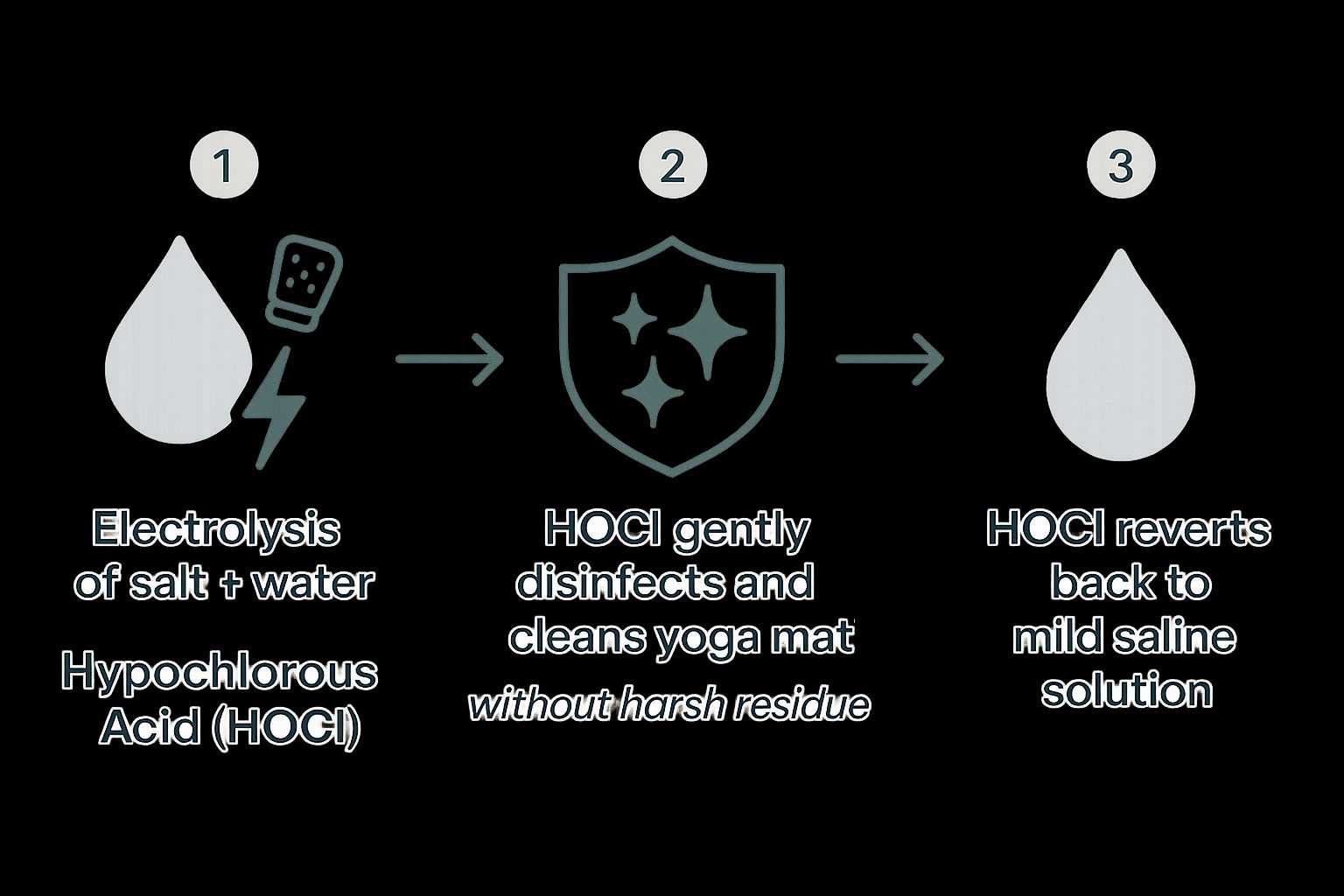
The process starts and ends with basic elements, which ensures no harsh compounds enter your home. This approach is well-suited for a minimal, safety-conscious lifestyle grounded in proven science. If you want to learn more about its uses, you can explore this versatile hypochlorous acid disinfectant spray and how it works.
The effectiveness of HOCl comes from its simple composition, not a long list of additives. It is a cleaning solution that respects the quiet, safe environment of your practice and home.
This method provides a confident clean without compromises. It is an effective solution that is compatible with your body, gentle on your mat, and suitable for your home.
A Simple Routine for a Consistently Clean Mat

Keeping your mat clean does not need to be complicated. A simple, mindful routine is all it takes to maintain a fresh surface. When you use a gentle, HOCl-based non toxic yoga mat cleaner, you can achieve a thorough clean in moments.
Consistency is more important than intensity. A light wipe-down after every use prevents the buildup of sweat and oils. This habit takes less than a minute and helps your mat feel better and last longer.
The Two-Step Cleaning Process
Your routine involves two simple actions. First, lightly mist your mat’s surface with the cleaner. There is no need to saturate it; a few sprays are sufficient.
Next, wipe the entire surface with a clean, soft cloth. A microfiber towel works well, as it gently lifts away grime without being abrasive. Wipe down the whole mat evenly to remove any lingering moisture.
The most important step is allowing your mat to air dry completely before rolling it up. This prevents trapped moisture and ensures the surface is neutral and ready for your next session.
Tips for Long-Term Mat Care
Incorporating this small habit creates a consistently clean space for you to use. A clean mat is more than just hygienic; it is a calm foundation for your practice.
A few simple storage tips also help keep your mat in prime condition:
- Store it properly: Once dry, roll your mat loosely. Store it in a cool, dry place away from direct sunlight, which can degrade the material.
- Clean both sides: Occasionally, flip your mat over and give the underside a quick clean, as it picks up dust from the floor.
This straightforward routine supports a clear mind and a healthy home. If you are curious about simplifying other tasks, our guide to the best non toxic all purpose cleaner shows how this gentle approach can be used all around your home.
Embracing a Calmer, Cleaner Practice
A clean yoga mat is the foundation of a focused, peaceful practice. When you choose a cleaner that is both effective and gentle, you create a sanctuary. It is a space free from harsh chemical residues and distracting synthetic fragrances.
This mindful approach does more than preserve your mat. It supports the well-being of your entire household. It allows you to step onto your mat with confidence, knowing your personal space is genuinely clean and suitable for your home.
A Commitment to a Healthier Lifestyle
Your cleaning routine is a small act that reinforces a larger commitment to an intentional life. It is about ensuring the tools you use for wellness are cared for in a way that aligns with your goals for a calm, healthy home.
This small act reinforces a commitment to a healthier, more intentional lifestyle. Your practice space becomes a reflection of your values.
This consistency helps create a positive feedback loop. It turns a simple chore into a moment of self-care. To embrace this calmer and cleaner practice, you might also consider incorporating a collection of less toxic favorites into your daily routine.
Luma Living’s approach is built on this principle. We believe that a clean home environment supports overall peace of mind. It’s about achieving a confident clean without compromise.
Common Questions About Non-Toxic Mat Cleaning
Switching to a new cleaner for your yoga mat can bring up a few questions. People often wonder if a gentle cleaner can be effective or how to care for a specific type of mat. Let's address a few common inquiries.
How often should I clean my yoga mat?
For best results, a quick wipe-down with a non toxic yoga mat cleaner after each session is ideal. This simple step takes only seconds and prevents the buildup of sweat and oils. A more thorough cleaning once a week is also recommended, depending on how often you practice.
Is a gentle cleaner safe for all mat materials?
A HOCl-based cleaner is remarkably gentle. It works well for most common mat materials, including natural rubber, cork, PVC, and TPE. Because it is free of harsh solvents, it cleans without causing damage or leaving a sticky residue. That said, it is always a good practice to test a small, inconspicuous area first.
If you are dealing with deeper moisture-related issues, it may be worth exploring guides on natural and non-toxic mould killer solutions for more targeted advice.
The versatility of this simple approach is a key benefit. You can use the same spray on other fitness gear, children's toys, and any high-touch surface where a residue-free clean matters.
At Luma Living, our goal is to provide effective solutions for a truly clean home. Our HOCl-based cleaner offers peace of mind for your yoga mat and beyond, delivering a powerful clean without compromise. Learn more at https://lumaliving.co.
